With Earth Day fast approaching, I’ve been thinking more about diet from a sustainable angle. Sure, there are the top lists that profess eating local, organic, in season, etc., but there really is so much more to it. We have to sustain our bodies, our wallets, economies, and the environment. In reality, there is no perfect food that is 100% sustainable. But, from what I’ve learned, there seem to be choices that stand above others and can be incorporated into the daily ritual of many via some sustainable smoothie recipes.
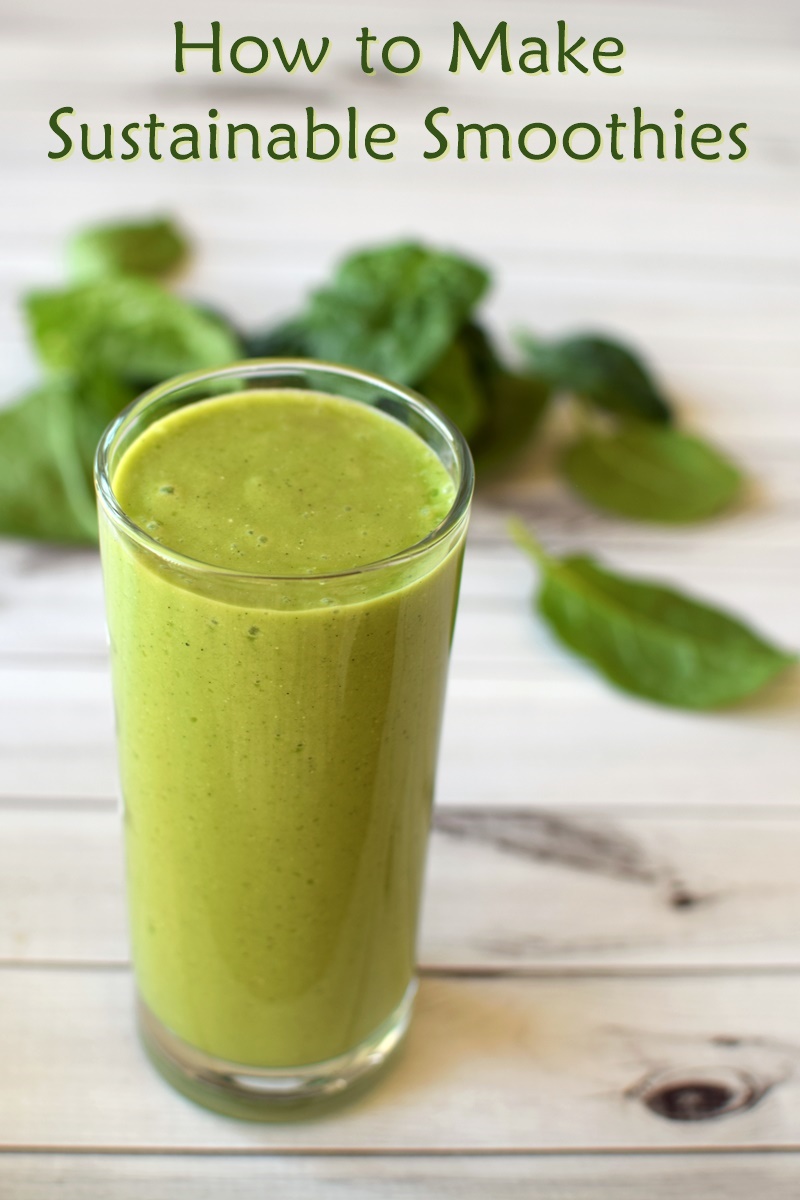 Please note that this sustainable smoothie post is for informational purposes only and based on research and reports that I read. It should not be construed as medical or nutritional advice and data can change with the seasons! Choose the options that are right for you. This post is sponsored by Silk, but the opinions are my own.
Please note that this sustainable smoothie post is for informational purposes only and based on research and reports that I read. It should not be construed as medical or nutritional advice and data can change with the seasons! Choose the options that are right for you. This post is sponsored by Silk, but the opinions are my own.
Foods for Building a Sustainable Smoothie
To create a sustainable smoothie in my blender, I first broke it down by component:
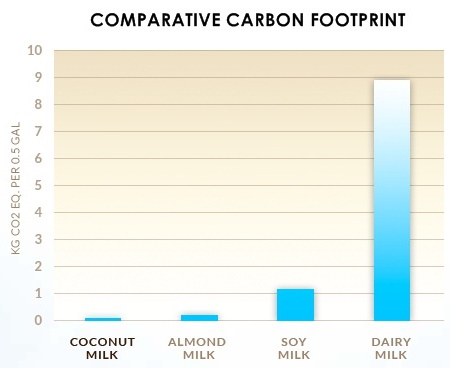 The Liquid: Dairy-free seems to be priority when it comes to environmental impact. As you can see in the comparative carbon footprint chart at right, which is based on Life Cycle Assessment Data (energy demand, greenhouse gases, ozone depletion, water consumption, waste, and more), plant-based milk alternatives are the clear winners for a gentle footprint, with coconut milk treading the lightest. Dairy-free cashew milk beverage wasn’t included in the data, but I’ve been told by a manufacturing company that it rivals coconut milk in earth friendliness (particularly when the nuts are properly sourced).
The Liquid: Dairy-free seems to be priority when it comes to environmental impact. As you can see in the comparative carbon footprint chart at right, which is based on Life Cycle Assessment Data (energy demand, greenhouse gases, ozone depletion, water consumption, waste, and more), plant-based milk alternatives are the clear winners for a gentle footprint, with coconut milk treading the lightest. Dairy-free cashew milk beverage wasn’t included in the data, but I’ve been told by a manufacturing company that it rivals coconut milk in earth friendliness (particularly when the nuts are properly sourced).
The Protein: These powders are all the rage for upping nutrition, and based on grams of protein, they do seem to be a good environmental option. But to make the most sustainable smoothie, the source should be considered. The most popular dairy-based protein powder, whey, isn’t sustainable for many bodies – due to allergies, intolerance, other health concerns, or beliefs. It can also run risks of hormones and antibiotics (from the cows which it is made), and has been shown to have concerning amounts of heavy metals with some brands. In terms of sustainable plant-based proteins, it appears that pea and hemp may be the winners. Legumes, such as peas, actually give back to the environment by reducing the need for fossil fuel fertilizers, and hemp continues to receive accolades for its hearty sustainability.
The Fruit: For me, a smoothie just isn’t the same without some sweet, ripe, energizing fruit. This is the trickiest territory as fruit, particularly the fleshy varieties that we love to put in smoothies, can be massive water consumers and many varieties have higher pesticide loads and deforestation issues. Choosing in-season, local, and organic for some is a good rule of thumb, but these are my personal favorite picks by season (see below for seasonal sustainable smoothie recipes!):
- Winter: Oranges – Fresh-squeezed orange juice (straight from the fruit!) is a domestic luxury in the cooler months with a low pesticide load and modest water usage in production.
- Spring: Pineapple – Tropical fruit is contested in sustainability, but domestic or Costa Rican pineapple shows promise and has a light water footprint as well as very low pesticide concerns.
- Summer: Organic Strawberries – They use far less water to produce than other berries, stone fruit or melons in the research that we read. Traditional strawberries are a pesticide concern, but buying domestic, organic varieties when in season is usually a minor investment.
- Fall: Pears and Pomegranates – Pomegranates can tolerate drought-like conditions while sweet pears are often produced domestically, aren’t water hogs, and have a low pesticide load (even non-organic according to Consumer Reports – their research appears more diligent than the EWG).
The Greens: It’s hard to beat spinach and kale for both sustainability and nutritional density. They grow quite fast in most climates, lowering the resources needed to grow them. I prefer spinach as it blends in more seamlessly, and has both lower pesticide concerns and very low water usage. But if you like the taste of raw kale, then your body may like it’s higher level of minerals, too.
The Sweetener: If the fruit isn’t quite ripe enough, sometimes a little sweetener is in order. Maple syrup seems to shine in sustainability, while coconut sugar does live up to some of the environmental hype. For sugar-free, stevia does have some environmental concerns, but purchasing Organic or Rainforest Alliance Certified can alleviate most of these issues. And since stevia is produced more naturally and proportionately used in such small quantities, it’s impact is presumably much lighter than most sugar-free sweeteners.
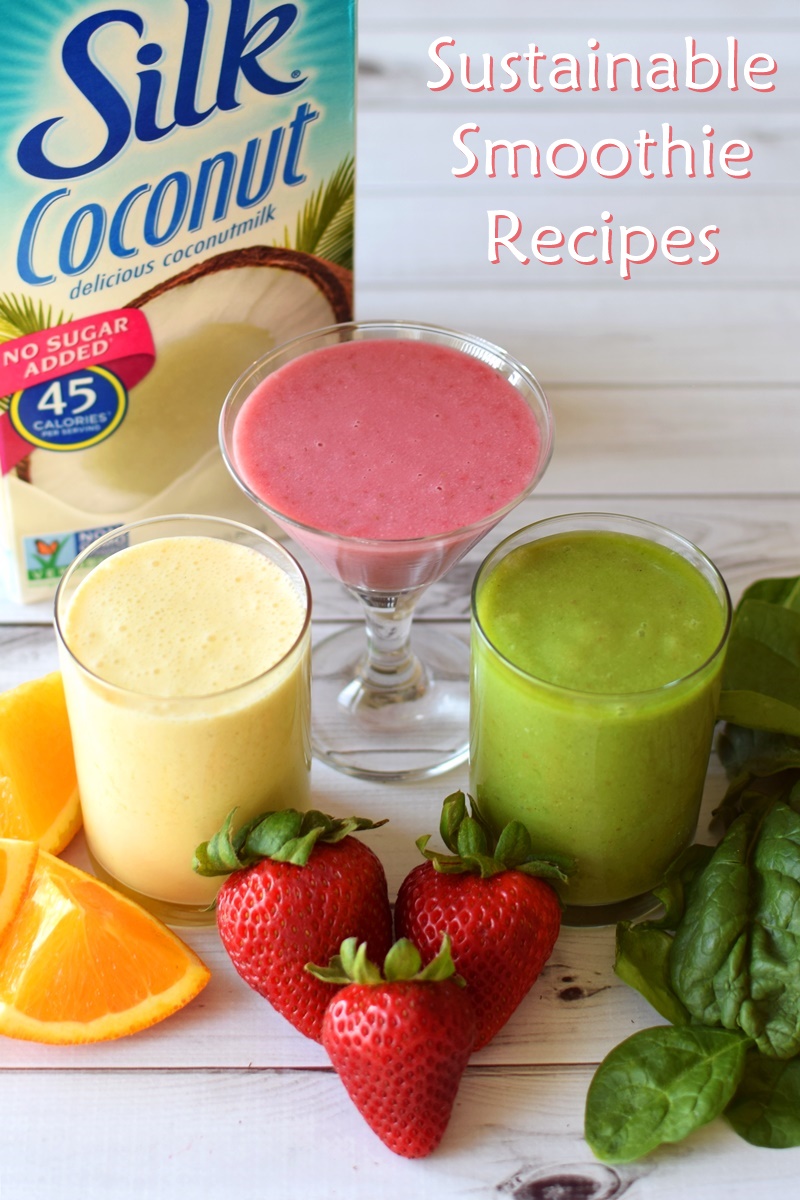
Our Favorite Sustainable Smoothie Recipes by Season
Creamsicle Winter Sustainable Smoothie (shown above at left): Blend 2/3 cup fresh-squeezed orange juice, 1/2 cup coconut milk frozen into cubes, 1 tablespoon vanilla pea protein powder, and 1/8 teaspoon turmeric.
Berry-licious Summer Sustainable Smoothie (shown above in the middle): Blend about 10 medium strawberries, 1/2 cup unsweetened cashew milk beverage, 1 ounce cashews (finely ground in a spice grinder), a squeeze of lemon juice, and 5 drops of organic stevia or coconut sugar, to taste.
Green Pear Fall Sustainable Smoothie (shown above at right): Blend 1 ripe pear (cored), 1/2 cup unsweetened coconut milk beverage, 1 tablespoon vanilla pea protein powder, a handful of spinach, and crushed ice (as much as you like).
Tropical Spring Sustainable Smoothie (recipe and photo below) …
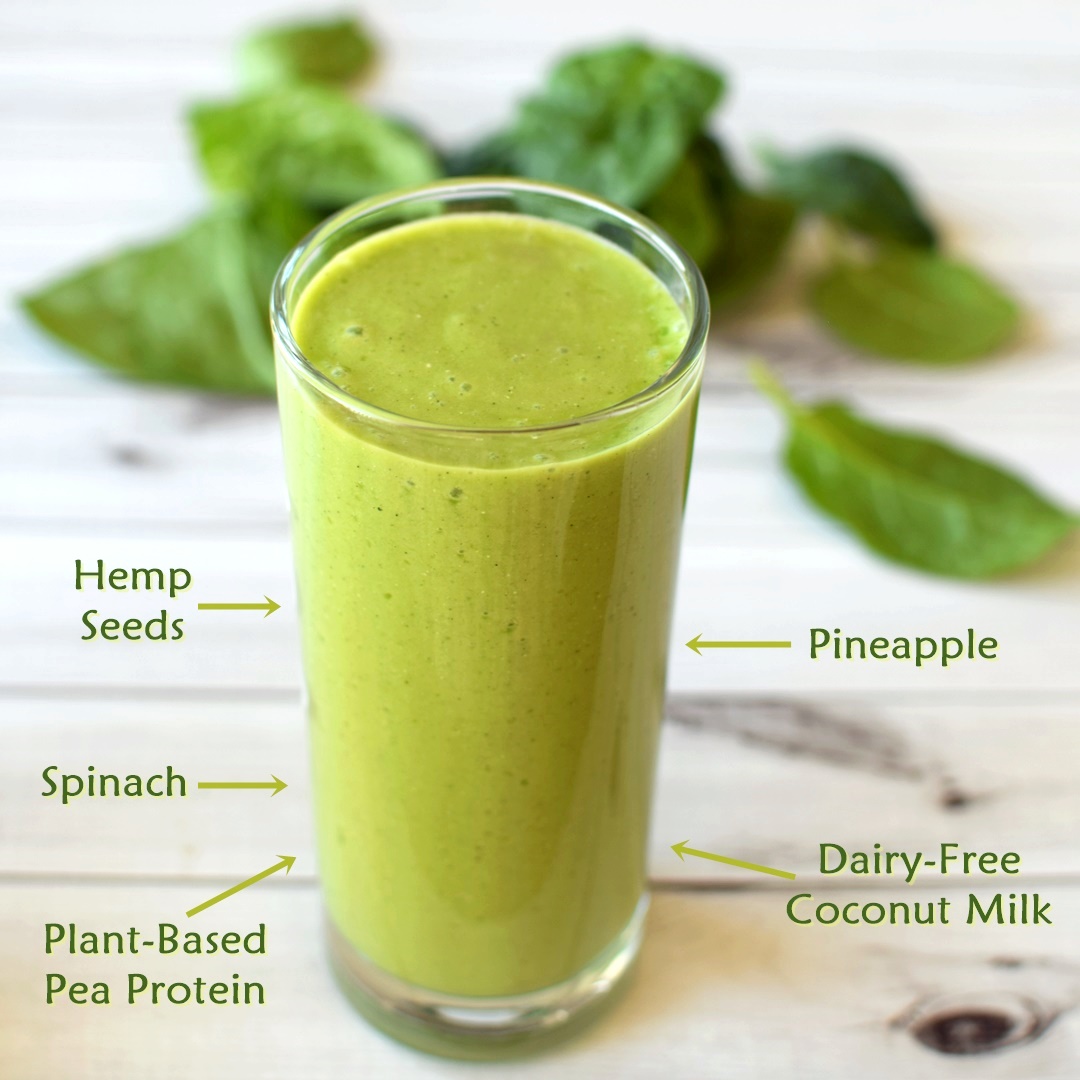
Special Diet Notes: Tropical Spring Sustainable Smoothie
By ingredients, this recipe is dairy-free / non-dairy, egg-free, gluten-free, grain-free, nut-free, peanut-free, soy-free, vegan / plant-based, vegetarian, generally top food allergy-friendly, and optionally paleo.
- 1 cup frozen pineapple (see post above on fruit options)
- 1 cup unsweetened coconut milk beverage (I used Silk), divided
- ½ tablespoon shelled hemp seeds
- 2 tablespoons pea protein powder (see sweetness note below)
- Handful fresh spinach leaves (can sub kale leaves - if you like raw kale!)
- Add the fruit, about ¾ cup of the milk beverage, hemp seeds, protein powder and spinach to your blender and puree until smooth and no bits of spinach or hemp remain.
- Blend in the remaining ¼ cup milk beverage, or to your desired consistency.
Sweetness: If using a pea protein powder that isn't vanilla or a lightly sweet original, a sustainable sweetener choice for this smoothie is coconut sugar. Or you can add just a few drops of pure stevia - since it is used in such small quantities and is low glycemic, stevia is often considered a sustainable option.
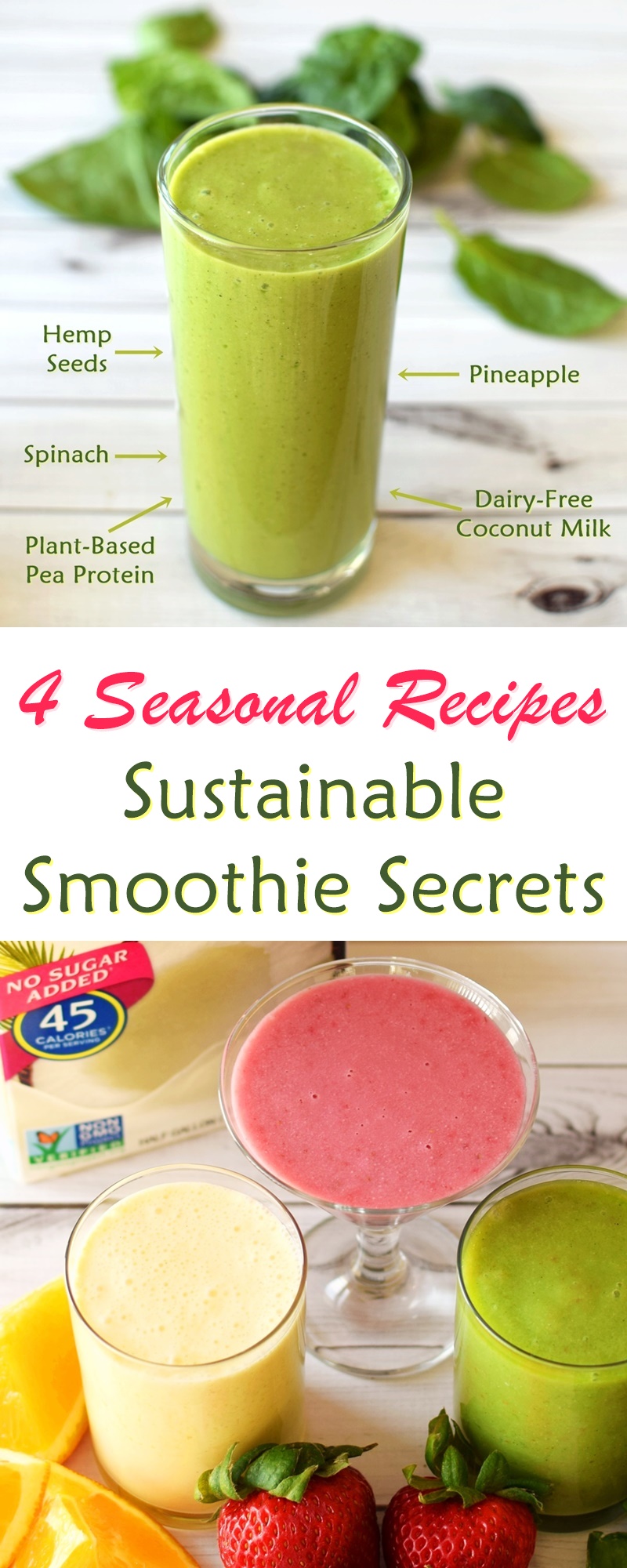


35 Comments
Pingback: 22 Sustainable Recipes for Earth Day and Every Day
Pingback: Sugar-free, vegan summer drinks and smoothies
Pingback: The Best Earth Day Books for Food Lovers - Go Dairy Free
Pinning this right now to keep on hand for this summer. I drink a ton of smoothies in the summer, I’ve been in love with them for years and YES to using Silk Coconut milk!
That’s fabulous Angie! I hope this post and my recipes inspire you for more deliciousness this summer – and year round 🙂
Thanks for the thoughtful, informative post- I learned a lot! These smoothies all look refreshing and delicious. We drink a lot of smoothies in my house because it’s an easy way to incorporate fruits and veggies into my daughter’s diet. We use Silk almond milk and cashew milk a lot but I haven’t tried the coconut milk. I’ll have to try it- it sounds delicious with the pineapple.
The coconut milk beverage is delicious and surprisingly versatile – we don’t find it overly coconut. But I’ve become a big fan of the cashew, too. Than you Sonali!
Who doesn’t love a good healthy smoothie?! The seasonal aspect is great!
What a wonderful idea to clean up your eating in a whole new way. Thanks for the inspiration. I’m off to pull out that blender!
Haha, thank you Julie – I hope you put that blender to good use with all of the warm weather ahead!
I’d love to try the green pear smoothie. It sounds so refreshing! Thank you for this guide.
It was a favorite – I hope you get the chance to enjoy it Whitney!
I love that you show a chart of seasonal fruit. It helps to make it easier to make sustainable smoothies. Thanks!
I aim to please and make healthy living easier 🙂
Wow, this is such a great informative post Alisa! The smoothie looks fantastic! I don’t really do smoothies hardly ever, but if I do I almost always love fresh orange juice in mine, it’s the best!
Good call – you really can’t beat fresh squeezed OJ! Sweet and nutrient-rich.
I love that you are encouraging sustainability. It is so important. Great, simple and healthy smoothie recipes too!
Thank you Mel! I definitely believe in considering all sides of sustainability – it’s such a broad topic that tends to get narrowed in scope.
Great information for sustainable smoothies and I really appreciate your recipe. Thanks!
Thank you Ginny! I hope you get the chance to enjoy it some time 🙂
Wow, what a great post!! Sustainability is such an important factor in what we eat but sometimes it gets overlooked if it’s not meat.
I couldn’t agree more Lauren – it’s a topic that often gets discussed on the surface level.
Yay! No bananas! This sounds wonderful. Great guide too!
Yes, totally banana-free smoothies! In fact, no mango or avocado either – there seems to be requests for this a bit!
This is the most thoughtful smoothie post I’ve ever read. Why not strive for sustainability while making it delicious too? Love this.
Thank you so much Toni – I love doing the research side of things, too – and that means a lot coming from a locavore 🙂
Great tips here! And I love all those plant-based smoothies!
Thanks Jenn! It was really fun to learn and put this together.
Pingback: Bob's Red Mill Nutritional Booster Protein Powders (Review)
This smoothie looks so good and healthy – I must try it. And thank you for sharing that sustainable information with us. So helpful!
Thank you Citra! I hope you do get the chance to trial these smoothies 🙂
Love this!! I have a post coming up in a few weeks where I’m taking a similar angle. I think it’s so great to have build it yourself stuff like these. I want every one of those!
Thanks Sophia, I can’t wait to see what deliciousness you share!
These smoothies all look so amazing and the sustainable ingredient guide is so helpful!